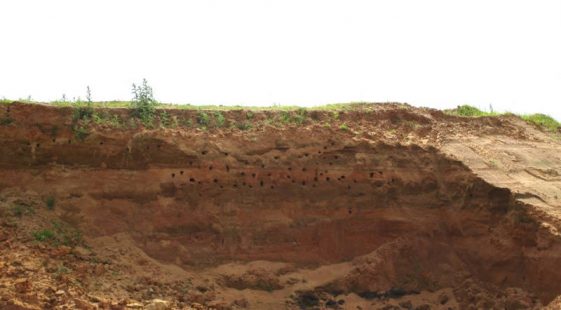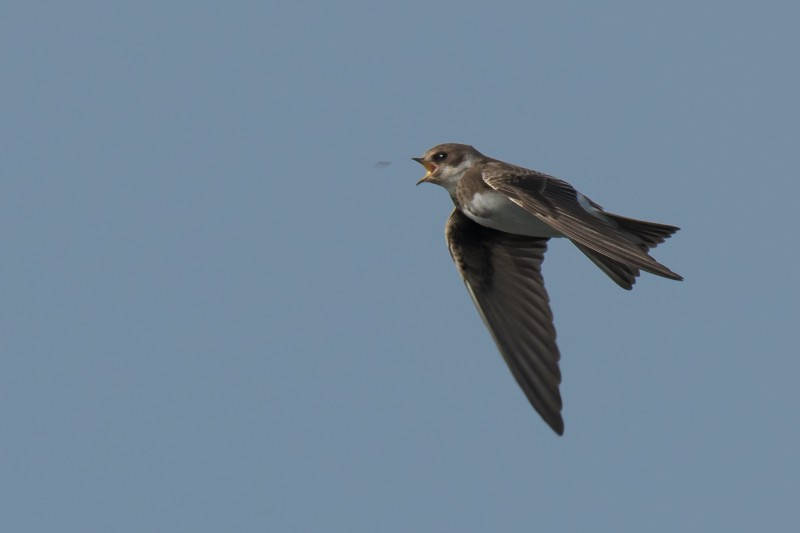Sand Martins are possibly one of the most familiar birds to anyone working in a sand and gravel quarry. This is the key time to see them as they return to the UK for breeding, but what else do you know about them?
The scientific name of the Sand Martin, Riparia, means “riverbank.” With their traditional home being sandy sided riverbanks; so, their food consists of small insects, mostly gnats and other flies that are associated with waterways and lakes. However, any steep sided sand bank is potentially a nesting site.
If you manage a site with sand or even dust piles that attract Sand Martins there are two key measures to follow; firstly, maintain an area suitable for their nesting with a sheer sand face, away from operational activities, and secondly keep operational sand piles sloped at 45 degrees or less to ensure the Sand Martins don’t choose working piles as their new nest site. Please read the CEMEX guidance sheet.
Although Sand Martins are maintaining a healthy population that doesn’t mean they don’t face several challenges. One of the amazing facts about Sand Martins is their migration, they winter in east and southern Africa by crossing the Sahara Desert nonstop (as there’s nowhere to feed!). The Sahara is the largest desert in the world, measuring approximately 3,000 miles from east to west and 1,200 miles from north to south. Before crossing the Sahara Desert, the Sand Martins store up just enough fat to keep them going through the journey without needing to refuel. Without enough fat, they won’t have the energy to make the crossing, but if they store too much fat they’ll be weighed down and their flight won’t be efficient. All of this is from a bird that is just 12-14cm long, weighs 13.5g and lives on gnats! Knowing this might bring a little more sympathy and admiration for them when you see the Sand Martins return this spring from their 10,000 mile journey.
This species originally nested in the steep, sandy banks of rivers, but have adapted to using many different man-made sites with Sand Martins banks often added to CEMEX sites’ restoration schemes.
An example of this can be found at Berkswell quarry. Andy Barber, Quarry Manager at Berkswell quarry, explains: “We built a Sand Martin ‘Hotel’ at Berkswell a few years ago, to provide somewhere for the birds to nest while protecting our excavation. It now only requires minimal maintenance each year – the birds tend to arrive on site from April onwards, so before this we scrape the face of the ‘Hotel’ to make sure it is clean and vertical. As soon as the birds start arriving we leave it alone. There are around 60 holes on the ‘Hotel’ for the Sand Martins to nest in and generally we see about 50-60 pairs using it each year.
 They’re lovely little birds and it’s interesting to watch them return each year – they often seem to return to the same hole. It’s phenomenal how they create their nests really and it’s great that they can have a safe haven with us. We should be doing what we can to help the wildlife that uses our sites – it’s important to get the balance between maintaining habitats and continuing our operations.
They’re lovely little birds and it’s interesting to watch them return each year – they often seem to return to the same hole. It’s phenomenal how they create their nests really and it’s great that they can have a safe haven with us. We should be doing what we can to help the wildlife that uses our sites – it’s important to get the balance between maintaining habitats and continuing our operations.
The birds seem to be returning a little slower this year, perhaps because it is quite cold for April. We always look forward to welcoming them back to our site!”
(Pictured: Sand Martin by Tim Melling and Sand Martin Hotel at Berkswell quarry by Andy Barber)
For more information about Sand Martins visit:
